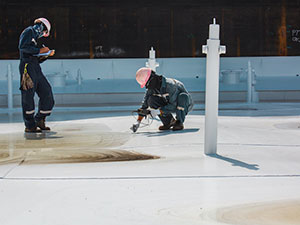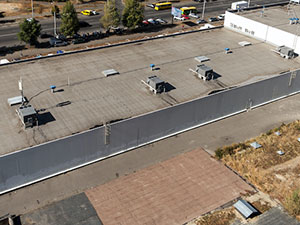
Single-ply roof repair maintains and restores EPDM, TPO, and PVC roofs. These materials are preferred for their durability, versatility, and ease of installation. Thermal expansion and contraction, seam failures, and punctures can damage single-ply membranes, which provide a smooth barrier to water and UV radiation.
A quality single-ply roof repair extends the roofing system’s longevity, optimizes performance, and prevents additional damage. Routine inspections and rapid repairs are essential to roof functionality and cost savings. Call Woolbright’s Roofing and Construction in Homeland, CA at 951-609-1818 to book a consultation.
Single-Ply Roof Repair Process

For longevity and convenience of installation, EPDM, TPO, and PVC single-ply roofing systems are preferred. For repairs, follow these steps:
Find the Issue
Visual Inspection: Check for tears, punctures, blisters, and torn seams. Water Test: Leaks might be hard to find. Using a hose to imitate rain can help you identify a leak.
Gather Materials Repair Kit
Most single-ply roofs have particular kits. Select the proper EPDM, TPO, or PVC for your roofing material.A utility knife, brush, roller, cleaner (isopropyl alcohol for TPO/PVC), and glue or patches may be needed.
Cleanup
Remove Debris: Clean the repair area of dirt, leaves, and loose items.
To ensure adhesion, clean the surface with a roofing material-specific cleaning. A special EPDM cleaner may work. Isopropyl alcohol works for TPO/PVC.
Heat if necessary.
A heat gun may be needed to seal TPO or PVC repair or seam tape edges. Take care not to overheat or damage the roof.
Verify Adhesion
Inspect: Make sure the patch is sealed with glue and there are no gaps after the repair.
Final Checkup
Check the Roof: Make sure everything is secure and there are no evident difficulties after the fix.
Routine Care
Check your roof often to spot problems early and maintain it.
Long-Lasting Single-Ply Roof Repair
Single-ply roof repairs are necessary to maintain your roofing system. First, check for tears, holes, and damaged seams. Clean the affected region of contaminants and debris to improve adhesion. The right repair kit may contain sealants or patches, depending on the damage. Apply these materials according to the manufacturer’s instructions and use heat for TPO or PVC roofs. Check the area after the repair to be sure the adhesive or patch was properly applied. Routine roof inspections and maintenance help you spot issues early and extend its lifespan. If the damage is significant or you are unsure how to repair it, see a professional to ensure a proper and long-lasting repair. Call Woolbright’s Roofing and Construction in Homeland, CA at 951-609-1818 to book a consultation.
